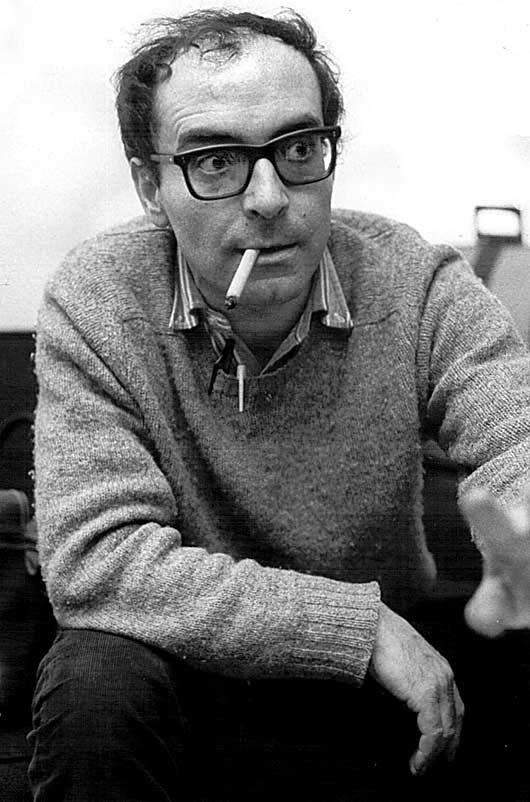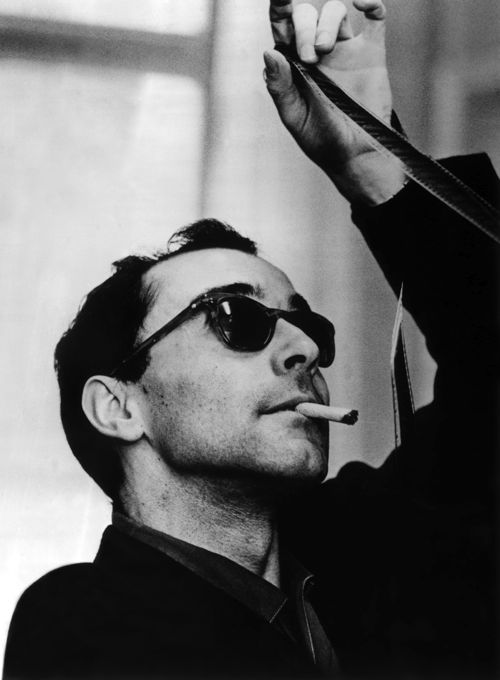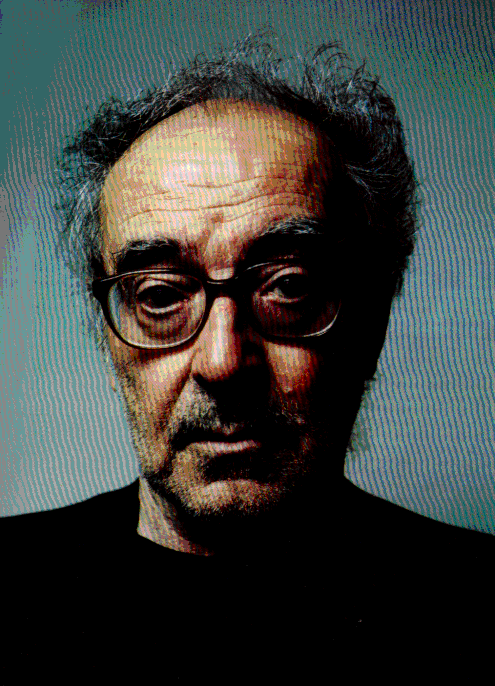<Back to Index>
- Film Director and Screenwriter Jean - Luc Godard, 1930
PAGE SPONSOR
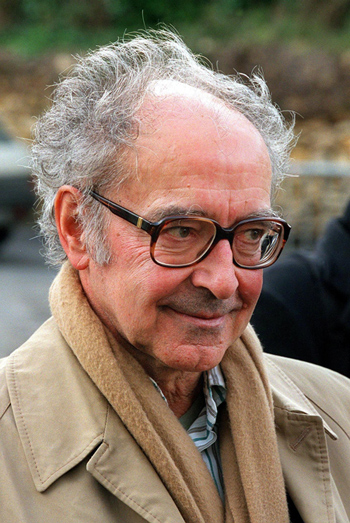
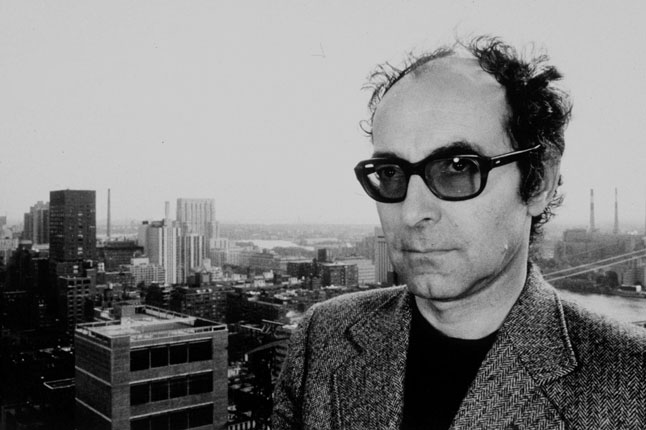
Jean - Luc Godard (born 3 December 1930) is a French - Swiss film director, screenwriter and film critic. He is often identified with the 1960s French film movement La Nouvelle Vague, or "New Wave".
Like his New Wave contemporaries, Godard criticized mainstream French cinema's "Tradition of Quality", which "emphasized craft over innovation, privileged established directors over new directors, and preferred the great works of the past to experimentation." To challenge this tradition, he and like - minded critics started to make their own films. Many of Godard's films challenge the conventions of traditional Hollywood in addition to French cinema. He is often considered the most radical French filmmaker of the 1960s and 1970s. Several of his films express his political views. His films express his knowledge of film history through their references to earlier films. In addition, Godard's films often cite existentialism, as he was an avid reader of existential and Marxist philosophy. His radical approach in film conventions, politics and philosophies made him an influential filmmaker of the French New Wave.
After the New Wave, his politics had been much less radical and his later films are about representation and human conflict from a humanist, not Marxist perspective.
In a 2002 Sight & Sound poll, Godard ranked third in the critics' top ten directors of all time (which was put together by assembling the directors of the individual films for which the critics voted). He created "one of the largest bodies of critical analysis of any filmmaker since the mid - twentieth century." He and his work have been central to narrative theory and have "challenged both commercial narrative cinema norms and film criticism's vocabulary." In 2010, Godard was awarded an Academy Honorary Award, but did not attend the award ceremony. Godard's films have inspired diverse directors like Martin Scorsese, Quentin Tarantino, Steven Soderbergh, D.A. Pennebaker, Robert Altman, Jim Jarmusch, Wong Kar - wai, Wim Wenders, Bernardo Bertolucci, Pier Paolo Pasolini, Paul Thomas Anderson, Arthur Penn, Hal Hartley, Richard Linklater, Gregg Araki, Jørgen Leth, John Woo, Richard Lester, Rainer Werner Fassbinder, Brian De Palma, Oliver Stone, Richard Ayoade and Ken Loach.
Godard was born in Paris on 3 December 1930, the son of Odile (née Monod) and Paul Godard, a Swiss physician. His wealthy parents came from Protestant families of Franco - Swiss descent, and his mother was the great - granddaughter of theologian Adolphe Monod. Relatives on his mother's side include composer Jacques - Louis Monod, naturalist Théodore Monod and pastor Frédéric Monod. Godard attended school in Nyon, Switzerland, and the Lycée Rohmer. In 1949, he registered for a certificate in anthropology at the University of Paris (Sorbonne), but did not attend class. He got involved with the young group of film critics at the ciné - clubs that started the New Wave. Godard originally only held French citizenship, when he then in 1953 became a citizen of Gland, canton of Vaud, Switzerland, possibly through simplified naturalization through his Swiss father.
After attending school in Nyon, Godard returned to Paris in 1948. It was there, in the Latin Quarter just prior to 1950, that ciné - clubs (film societies) were gaining prominence. Godard began attending these clubs, where he soon met the man who was perhaps most responsible for the birth of the New Wave, André Bazin, as well as those who would become his contemporaries, including Jacques Rivette, Claude Chabrol, François Truffaut, Jacques Rozier and Jacques Demy. Godard was part of a generation for whom cinema took on a special importance. He has said: "In the 1950s cinema was as important as bread – but it isn't the case any more. We thought cinema would assert itself as an instrument of knowledge, a microscope ... a telescope.... At the Cinémathèque I discovered a world which nobody had spoken to me about. They'd told us about Goethe, but not Dreyer. ... We watched silent films in the era of talkies. We dreamed about film. We were like Christians in the catacombs."
His approach to film began in the field of criticism. Along with Éric Rohmer and Rivette, he founded the short lived film journal, Gazette du cinéma, which saw publication of five issues in 1950. When Bazin co-founded the influential critical magazine Cahiers du cinéma in 1951, Godard, with Rivette and Rohmer, was among the first writers. They, along with several other writers for Cahiers du cinéma in the 1950s, started making brief forays into film direction.
Godard, while taking a job as a construction worker on a dam in 1953, shot a documentary about the building, Opération béton (1955). As he continued to work for Cahiers, he made Une femme coquette (1955), a ten minute short; All the Boys Are Named Patrick (1957) another short fiction film; and Une histoire d'eau (1958), which was created largely out of unused footage shot by Truffaut.
In 1958 Godard, with a cast that included Jean - Paul Belmondo and Anne Colette, made his last short before gaining international prominence as a film maker, Charlotte et son Jules, a homage to Jean Cocteau.
His most celebrated period as a film maker is roughly from his first feature, Breathless (1960), through to Week End (1967) focused on relatively conventional works that often refer to different aspects of film history. This cinematic period stands in contrast to the revolutionary period that immediately followed it, during which Godard ideologically denounced much of cinema’s history as "bourgeois" and therefore without merit.
Godard's Breathless (À bout de souffle, 1960), starring Jean - Paul Belmondo and Jean Seberg distinctly expressed the French New Wave's style, and incorporated quotations from several elements of popular culture – specifically American cinema. The film employed various innovative techniques such as jump cuts, character asides and breaking the eyeline match rule in continuity editing. Truffaut co-wrote Breathless with Godard and introduced Godard to the producer who ultimately funded the film, Georges de Beauregard.
Godard viewed film making as an extension of criticism and was more interested in redefining film structure and style than actually being understood by the public. Often his movies were more about the presentation of a story than anything else. The stories in his films were very simple yet unfocused and constantly digressing from the main story line (Jean - Luc Godard and Vivre Sa Vie by Tom Milne, 1962).
From the beginning of his career, Godard included more film references into his movies than any of his New Wave colleagues. In Breathless, his citations include a movie poster showing Humphrey Bogart (whose expression the lead actor Jean - Paul Belmondo tries reverently to imitate); visual quotations from films of Ingmar Bergman, Samuel Fuller, Fritz Lang, and others; and an onscreen dedication to Monogram Pictures, an American B-movie studio. Most of all, the choice of Jean Seberg as the lead actress was an overarching reference to Otto Preminger, who had discovered her for his Saint Joan, and then cast her in his acidulous 1958 adaptation of Bonjour Tristesse. If, in Rohmer’s words, "life was the cinema", then a film filled with movie references was supremely autobiographical.
The following year, Godard made Le Petit Soldat (The Little Soldier), which dealt with the Algerian War of Independence. Most notably, it was the first collaboration between Godard and Danish born actress Anna Karina, whom he later married in 1961 (and divorced in 1967). The film, due to its political nature, was banned by the French government until January 1963. Karina appeared again, along with Belmondo, in A Woman Is a Woman (1961), intended as a homage to the American musical. Angela (Karina) desires a child, prompting her to pretend to leave her boyfriend (Jean - Claude Brialy) and make him jealous by pursuing his best friend (Belmondo) as a substitute.
Godard's next film, Vivre sa vie (My Life to Live) (1962), was one of his most popular among critics. Karina starred as Nana, an errant mother and aspiring actress whose financially straitened circumstances lead her to the life of a streetwalker. It is an episodic account of her rationalizations to prove she is free, even though she is tethered at the end of her pimp's short leash. In one touching scene in a cafe, she spreads her arms out and announces she is free to raise or lower them as she wishes. The film's style, much like that of Breathless, boasted the type of camera - liberated experimentation that made the French New Wave so influential.
Les Carabiniers (1963) was about the horror of war and its inherent injustice. It was the influence and suggestion of Roberto Rossellini that led Godard to make the film. It follows two peasants who join the army of a king, only to find futility in the whole thing as the king reveals the deception of war - administrating leaders. His most commercially successful film was Le Mépris (Contempt) (1963), starring Michel Piccoli and one of France's biggest female stars, Brigitte Bardot. A coproduction between Italy and France, Contempt became known as a pinnacle in cinematic modernism with its profound reflexivity. The film follows Paul (Piccoli), a screenwriter who is commissioned by the arrogant American movie producer Prokosch (Jack Palance) to rewrite the script for an adaptation of Homer's Odyssey, which the Austrian director Fritz Lang has been filming. Lang's 'high culture' interpretation of the story is lost on Prokosch, whose character is a firm indictment of the commercial motion picture hierarchy. Another prominent theme is the inability to reconcile love and labor, which is illustrated by Paul's crumbling marriage to Camille (Bardot) during the course of shooting.
In 1964, Godard and Karina formed a production company, Anouchka Films. He directed Bande à part (Band of Outsiders), another collaboration between the two and described by Godard as "Alice in Wonderland meets Franz Kafka." It follows two young men, looking to score on a heist, who both fall in love with Karina, and quotes from several gangster film conventions.
Une femme mariée (A Married Woman) (1964) followed Band of Outsiders. It was a slow, deliberate, toned down black and white picture without a real story. The film was entirely produced over the period of one month and exhibited a loose quality unique to Godard. Godard made the film while he acquired funding for Pierrot le fou (1965).
In 1965, Godard directed Alphaville, a futuristic blend of science fiction, film noir, and satire. Eddie Constantine starred as Lemmy Caution, a detective who is sent into a city controlled by a giant computer named Alpha 60. His mission is to make contact with Professor von Braun (Howard Vernon), a famous scientist who has fallen mysteriously silent, and is believed to be suppressed by the computer. Pierrot le fou (1965) featured a complex story line, distinctive personalities, and a violent ending. Gilles Jacob, an author, critic, and president of the Cannes Film Festival, called it both a "retrospective" and recapitulation in the way it played on so many of Godard’s earlier characters and themes. With an extensive cast and variety of locations, the film was expensive enough to warrant significant problems with funding. Shot in color, it departed from Godard’s minimalist works (typified by Breathless, Vivre sa vie, and Une femme mariée). He solicited the participation of Jean - Paul Belmondo, by then a famous actor, in order to guarantee the necessary amount of capital.
Masculin, féminin (1966), based on two Guy de Maupassant stories, La Femme de Paul and Le Signe, was a study of contemporary French youth and their involvement with cultural politics. An intertitle refers to the characters as "The children of Marx and Coca - Cola."
Godard followed with Made in U.S.A (1966), whose source material was Richard Stark's The Jugger; and Two or Three Things I Know About Her (1967), in which Marina Vlady portrays a woman leading a double life as housewife and prostitute. A Classic New Wave crime thriller, "Made in the U.S.A" is inspired by American Noir films. Anna Karina stars as the anti - hero searching for her murdered lover; includes a cameo by Marianne Faithful.
La Chinoise (1967) saw Godard at his most politically forthright so far. The film focused on a group of students and engaged with the ideas coming out of the student activist groups in contemporary France. Released just before the May 1968 events, the film is thought by some to foreshadow the student rebellions that took place.
That same year, Godard made a more colorful and political film, Week End. It follows a Parisian couple as they leave on a weekend trip across the French countryside to collect an inheritance. What ensues is a confrontation with the tragic flaws of the over - consuming bourgeoisie. The film contains some of the most written about scenes in cinema's history. One of them, an eight minute tracking shot of the couple stuck in an unremitting traffic jam as they leave the city, is cited as a new technique Godard used to deconstruct bourgeois trends. Startlingly, a few shots contain extra footage from, as it were, before the beginning of the take (while the actors are preparing) and after the end of the take (while the actors are coming out of character). Week End's enigmatic and audacious end title sequence, which reads "End of Cinema", appropriately marked an end to the narrative and cinematic period in Godard's film making career.
Politics are never far from the surface in Godard's films. One of his earliest features, Le Petit Soldat, dealt with the Algerian War of Independence, and was notable for its attempt to present the complexity of the dispute rather than pursue any specific ideological agenda. Along these lines, Les Carabiniers presents a fictional war that is initially romanticized in the way its characters approach their service, but becomes a stiff anti - war metonym. In addition to the international conflicts Godard sought an artistic response to, he was also very concerned with the social problems in France. The earliest and best example of this is Karina's potent portrayal of a prostitute in Vivre sa vie.
In 1960s Paris, the political milieu was not overwhelmed by one specific movement. There was, however, a distinct post war climate shaped by various international conflicts such as the colonialism in North Africa and Southeast Asia. The side that opposed such colonization included the majority of French workers, who belonged to the French communist party, and the Parisian artists and writers who positioned themselves on the side of social reform and class equality. A large portion of this group had a particular affinity for the teachings of Karl Marx. Godard's Marxist disposition did not become abundantly explicit until La Chinoise and Week End, but is evident in several films — namely Pierrot and Une femme mariée.
Godard was accused by some of harboring anti - Semitic views: in 2010, in the lead up to the presentation of Godard's honorary Oscar, a prominent article in the New York Times by Michael Cieply drew attention to the idea, which had been circulating through press in previous weeks, that Godard might be an anti - Semite, and thus undeserving of the accolade. Cieply makes reference to Richard Brody's book, "Everything is Cinema: The Working Life of Jean - Luc Godard," and alluded to a previous, longer article published by the Jewish Journal as lying near the origin of the debate. The article also draws upon Brody's book, for example in the following quotation, which Godard made on television in 1981: "Moses is my principal enemy... Moses, when he received the commandments, he saw images and translated them. Then he brought the texts, he didn't show what he had seen. That's why the Jewish people are accursed." Immediately after Cieply's article was published, Brody made a clear point of criticizing the "extremely selective and narrow use" of passages in his book, and noted that Godard's work has approached the Holocaust with "the greatest moral seriousness". Godard himself has previously identified explicitly as an anti - Zionist but has denied the accusations of anti - Semitism.
Godard produced several pieces that directly address the Vietnam War. Furthermore, there are two scenes in Pierrot le fou that tackle the issue. The first is a scene that takes place in the initial car ride between Ferdinand (Belmondo) and Marianne (Karina). Over the car radio, the two hear the message "garrison massacred by the Viet Cong who lost 115 men". Marianne responds with an extended musing on the way the radio dehumanizes the Northern Vietnamese combatants.
In the same film, the lovers accost a group of American sailors along the course of their liberating crime spree. Their immediate reaction, expressed by Marianne, is "Damn Americans!" an obvious outlet of the frustration so many French communists felt towards American hegemony. Ferdinand then reconsiders, "That’s OK, we’ll change our politics. We can put on a play. Maybe they’ll give us some dollars." Marianne is puzzled but Ferdinand suggests that something the Americans would like would be the Vietnam War. The ensuing sequence is a makeshift play where Marianne dresses up as a stereotype Vietnamese woman and Ferdinand as an American sailor. The scene ends on a brief shot revealing a chalk message left on the floor by the pair, "Long live Mao!" (Vive Mao!).
Notably, he also participated in Loin du Vietnam (1967). An anti - war project, it consists of seven sketches directed by Godard (who used stock footage from La Chinoise), Claude Lelouch, Joris Ivens, William Klein, Chris Marker, Alain Resnais and Agnès Varda.
Godard's engagement with German poet and playwright Bertolt Brecht stems primarily from his attempt to transpose Brecht's theory of epic theater and its prospect of alienating the viewer (Verfremdungseffekt) through a radical separation of the elements of the medium (in Brecht's case theater, but in Godard's, film). Brecht's influence is keenly felt through much of Godard's work, particularly before 1980, when Godard used filmic expression for specific political ends.
For example, Breathless' elliptical editing, which denies the viewer a fluid narrative typical of mainstream cinema, forces the viewers to take on more critical roles, connecting the pieces themselves and coming away with more investment in the work's content. Godard also employs other devices, including asynchronous sound and alarming title frames, with perhaps his favorite being the character aside. In many of his most political pieces, specifically Week End, Pierrot le fou, and La Chinoise, characters address the audience with thoughts, feelings and instructions.
A Marxist reading is possible with most if not all of Godard’s early work. Godard’s direct interaction with Marxism does not become explicitly apparent, however, until Week End, where the name Karl Marx is cited in conjunction with figures such as Jesus Christ. A constant refrain throughout Godard's cinematic period is that of the bourgeoisie’s consumerism, the commodification of daily life and activity, and man’s alienation — all central features of Marx’s critique of capitalism.
In an essay on Godard, philosopher and aesthetics scholar Jacques Rancière states, "When in Pierrot le fou, 1965, a film without a clear political message, Belmondo played on the word 'scandal' and the 'freedom' that the Scandal girdle supposedly offered women, the context of a Marxist critique of commodification, of pop art derision at consumerism, and of a feminist denunciation of women’s false 'liberation', was enough to foster a dialectical reading of the joke and the whole story." The way Godard treated politics in his cinematic period was in the context of a joke, a piece of art, or a relationship, presented to be used as tools of reference, romanticizing the Marxist rhetoric, rather than solely being tools of education.
Une femme mariée is also structured around Marx's concept of commodity fetishism. Godard once said that it is "a film in which individuals are considered as things, in which chases in a taxi alternate with ethological interviews, in which the spectacle of life is intermingled with its analysis". He was very conscious of the way he wished to portray the human being. His efforts are overtly characteristic of Marx, who in his Economic and Philosophical Manuscripts of 1844 gives one of his most nuanced elaborations, analyzing how the worker is alienated from his product, the object of his productive activity. Georges Sadoul, in his short rumination on the film, describes it as a "sociological study of the alienation of the modern woman".
The period that spans from May 1968 indistinctly into the 1970s has been subject to an even larger volume of varying labeling. They include everything from his "militant" period, to his "radical" period, along with terms as specific as "Maoist" and vague as "political". The period saw Godard align himself with a specific revolution and employ a consistent revolutionary rhetoric.
Amid the upheavals of the late 1960s Godard became interested in Maoist ideology. He formed the socialist - idealist Dziga - Vertov cinema group with Jean - Pierre Gorin and produced a number of shorts outlining his politics. In that period he traveled extensively and shot a number of films, most of which remained unfinished or were refused showings. His films became intensely politicized and experimental, a phase that lasted until 1980.
According to Elliott Gould, he and Godard met to discuss the possibility of Godard directing Jules Feiffer's 1971 surrealist play Little Murders. During this meeting Godard said his two favorite American writers were Feiffer and Charles M. Schulz. Godard soon declined the opportunity to direct; the job later went to Alan Arkin.
After the events of May 1968, when the city of Paris saw total upheaval in response to the "authoritarian de Gaulle republic", and Godard's professional objective was reconsidered, he began to collaborate with like minded individuals in the film making arena. The most notable of these collaborations was with a young Maoist student, Jean - Pierre Gorin, who displayed a passion for cinema that grabbed Godard’s attention.
Between 1968 and 1973, Godard and Gorin collaborated to make a total of five films with strong Maoist messages. The most prominent film from the collaboration was Tout va bien, which starred Jane Fonda and Yves Montand, at the time very big stars. Jean - Pierre Gorin later taught the study of film at the University of California, San Diego.
The small group of Maoists that Godard had brought together, which included Gorin, adopted the name Dziga Vertov Group. Godard had a specific interest in Vertov, a Soviet filmmaker — whose adopted name is derived from the verb to spin or rotate and is best remembered for Man with the Movie Camera (1929) and a contemporary of both the great Soviet montage theorists, most notably Sergei Eisenstein, and Russian constructivist and avant garde artists such as Alexander Rodchenko and Vladimir Tatlin. Part of Godard’s political shift after May 1968 was toward a proactive participation in the class struggle.
In 1972, Godard and Swiss filmmaker Anne - Marie Miéville started the alternative video production and distribution company Sonimage, based in Grenoble. Under Sonimage, Godard produced both Numero Deux (1975) and "Sauve qui peut (la vie)" (1980). In 1976, Godard began collaborating with Swiss filmmaker Anne - Marie Miéville, his wife, on a series of innovative video works for European broadcast television called "Six fois deux / Sur et sous la communication" (1976) and "France / tour / détour / deux / enfants" (1978).
His return to somewhat more traditional fiction was marked with Sauve qui peut (la vie) (1980), the first of a series of more mainstream films marked by autobiographical currents: for example Passion (1982), Lettre à Freddy Buache (1982), Prénom Carmen (1984), and Grandeur et décadence (1986). There was, though, another flurry of controversy with Je vous salue, Marie (1985), which was condemned by the Catholic Church for alleged heresy, and also with King Lear (1987), an extraordinary but much - excoriated essay on William Shakespeare and language. Also completed in 1987 was a segment in the film ARIA which was based loosely from the plot of Armide; it is set in a gym and uses several arias by Jean - Baptiste Lully from his famous Armide.
His later films were marked by great formal beauty and frequently a sense of requiem — Nouvelle Vague (New Wave, 1990), the autobiographical JLG / JLG, autoportrait de décembre (JLG / JLG: Self - Portrait in December, 1995), and For Ever Mozart (1996). Allemagne année 90 neuf zéro (Germany Year 90 Nine Zero, 1991) was a quasi - sequel to Alphaville but done with an elegiac tone and focus on the inevitable decay of age. Between 1988 and 1998 he produced perhaps the most important work of his career in the multi - part series Histoire(s) du cinéma, a monumental project which combined all the innovations of his video work with a passionate engagement in the issues of twentieth century history and the history of film itself.
Godard continued to work actively into his seventies. In 2001, Eloge de l'Amour (In Praise of Love) was released. This film is notable for its use of both film and video – the first half captured in 35 mm black and white, the latter half shot in color on DV – and subsequently transferred to film for editing. The blending of film and video recalls the statement from Sauve Qui Peut, in which the tension between film and video evokes the struggle between Cain and Abel. Eloge de l'Amour is rich with themes of aging, love, separation and rediscovery as we follow the young artist Edgar contemplating a new work on the four stages of love (should it be an opera? a film?). He meets up with a lost love who is terminally ill, and at her death we are thrust into the second half of the film where Edgar meets with her at her grandparent's house two years before. Producers for Steven Spielberg are negotiating the purchase of her grandparent's World War II story; the young woman attempts to stall the deal. This is one of Godard's most tender films, yet it is characteristically enigmatic and demands the viewer's full attention.
In Notre musique (2004), Godard turns his focus to war, specifically, the war in Sarajevo, but with attention to all war, including the American Civil War, the war between the U.S. and Native Americans, and the Israeli – Palestinian conflict. The film is structured into three Dantean kingdoms: Hell, Purgatory and Paradise. Godard's fascination with paradox is a constant in the film. It opens with a long, ponderous montage of war images that occasionally lapses into the comic; Paradise is shown as a lush wooded beach patrolled by US Marines.
Godard's Film Socialisme, premiered in the Un Certain Regard section at the 2010 Cannes Film Festival. It was released theatrically in France in May 2010.
He was rumored to be considering directing a film adaptation of Daniel Mendelsohn's The Lost: A Search for Six of Six Million, an award winning book about the Holocaust. He had stated that his next feature film would be called Adieu au Language (Farewell to Language), which would be shot in 3-D. The film would revolve around a couple who cannot communicate with each other until their pet dog acts as an interpreter for them.
- " From Hollywood to the Third World, from the mainstream to the Avant Garde, Godard's name is perhaps the only one that occurs wherever cinema is discussed or produced." – Colin Myles MacCabe
- " Like Picasso, Godard reveals to us throughout his work his world as source and subject; the artist's studio, the objects of his daily life, the references to and repetitions of his own works, the layering of words and images, the women he has loved, the horrors of war." – Mary Lea Bandy.
- " Godard's is an art of plastic age, of fluent, pliable, putty characters." – Raymond Durgnat
- " Godard's importance lies in his development of an authentic modernist cinema in opposition to (though, during the early period, at the same time within) mainstream cinema: it is with his work that film becomes central to our century's major aesthetic debate, the controversy developed through such figures as Lukacs, Brecht, Benjamin and Adorno as to whether realism or modernism is the more progressive form." – Robin Wood.
